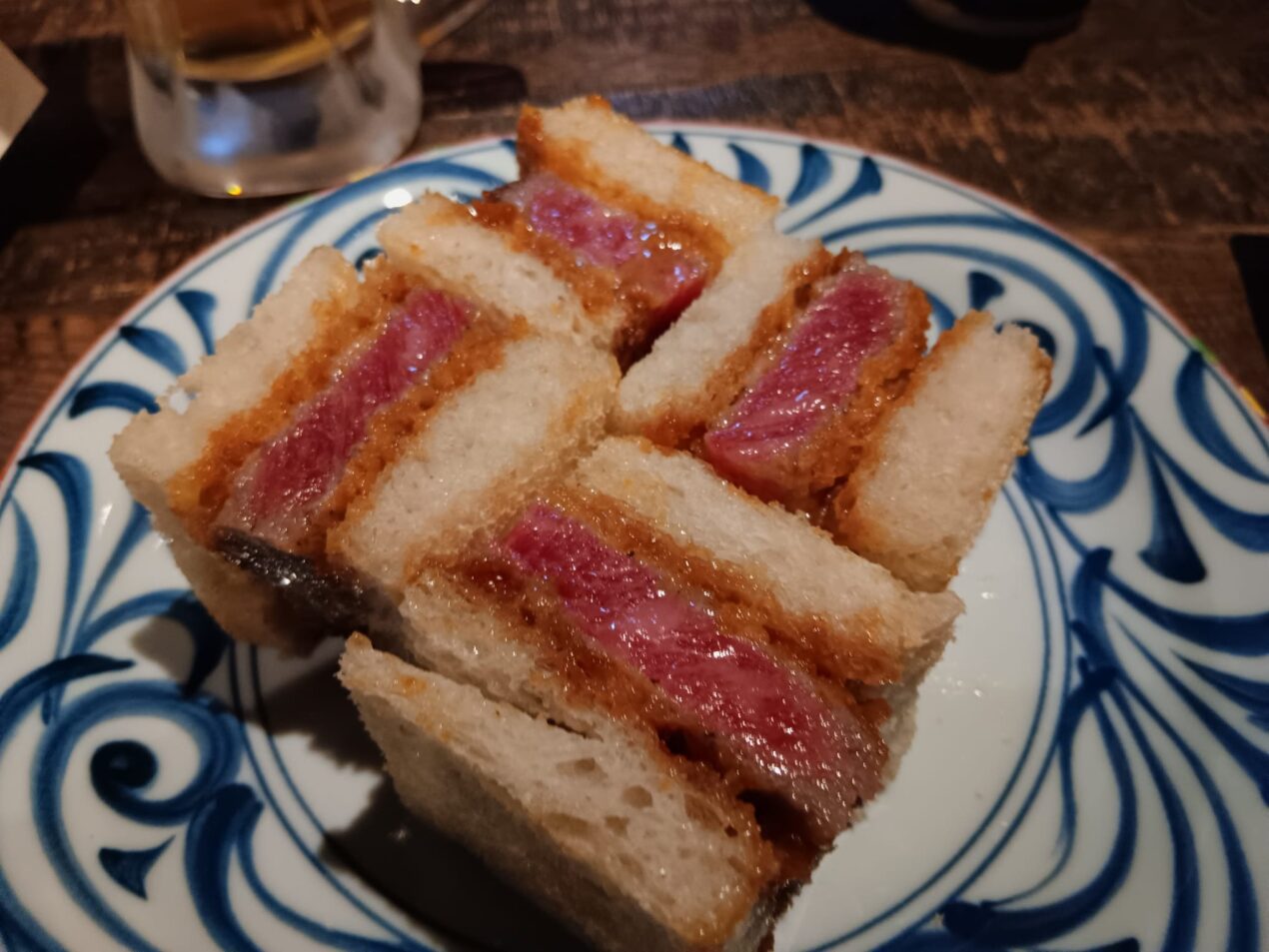A Man-Date at One of My Favorite Izakayas in Hong Kong: Uoharu
The first time I went to Uoharu was on a date where mid-way through, after watching her nod off face-first into her grilled mackerel and sake, I learned that she was on Clydesdale-sized doses of lithium. Somehow, after assurances it was just a fluke, the date continued. I spent the remainder of the night eating Scotch eggs at Stockton – while she subsequently nodded off again in the leather booth adjacent – and slugging fresh-off-the-tap cocktails from Draft Land – while she nodded off one more time on the stool next to me.
After the dust settled, I let her know that I had a nice time but I didn’t think we were compatible, to which she sent me a relatively accurate description of myself and one that makes me chuckle to this day. “You are a big sweaty piece of man meat.” I left out the accompanying expletives. This insult is only second to when a rotund Indian man with a handlebar mustache in Bangkok barked out at me, “Where do you think you’re going Daddy Longlegs?” after I hurried past him on Sukhumvit 11.
I digress. Uoharu’s seafood and robatayaki izakaya fare was the driving reason for my initial perseverance and self-convincing in the bathroom that “These things happen” and “I’m sure that she just had a long day.” I needed craved Uoharu redemption and returned countless times over the subsequent years, with it solidifying itself as one of my all-time favorite izakayas in Hong Kong.
In the lead-up to New Year’s Eve, I called up my top roll-dawg, bought him two roses and a box of chocolates, threw on my best pair of underpants (the one without any holes), and met him at Uoharu. It was a fitting, memorable end and man-date to close out 2023 with copious amounts of sake and izakaya fare. Here’s what I loved about it.
Thunniform Swimming Your Way to Uoharu (How to Get There)
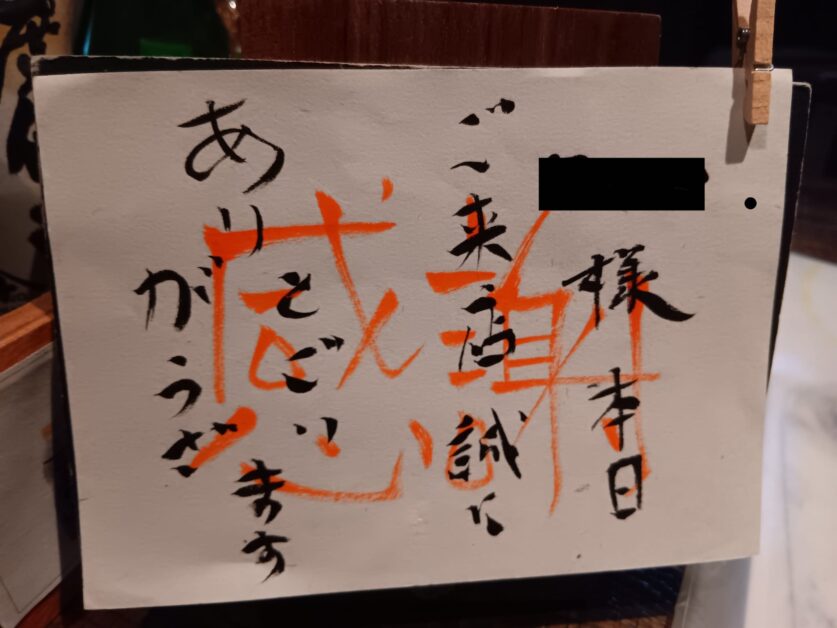
I thought it was a nice little touch that they wrote my name (where the blacked out rectangle is).
As of the date of publication, there are two primary Uoharu branches in Hong Kong. The first is my primary stomping grounds in the M88 Tower on Wellington Street (right near the entrance of Hong Kong’s famed party district Lan Kwai Fong). The second is in Admiralty’s Pacific Place.
Website, Address, & Details: https://www.instagram.com/uoharuhk/
- Address
- Price: $-$$
Uoharu actually originated in Tokyo and is a well-known seafood and robatayaki izakaya just a stone’s throw away from Chiyoda City (where you can find the Imperial Palace) and Tokyo’s Marunouchi Square (which borders Tokyo Station). They opened their first branch (M88) outside of Hong Kong in 2018, with a second location (Pacific Place) following suit in 2021.
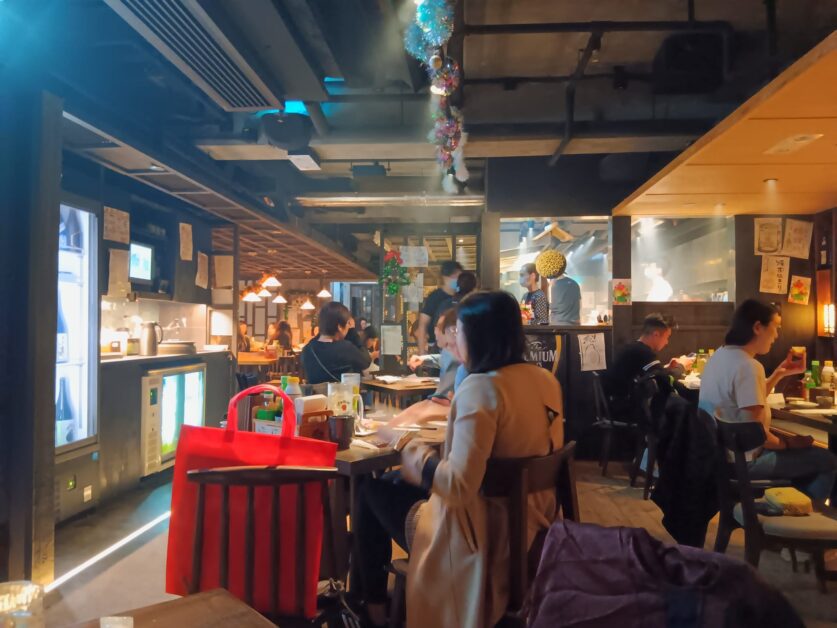
First, Uoharu is cozy. I don’t mean this in a disingenuous way that you tell your friend when they’ve moved into a 150-square-foot apartment to make them feel better. I mean this in the way that you feel like you’re stepping into a traditional Japanese izakaya and remote cabin in the woods hybrid – like if Kathy Bates fed James Caan delicious wagyu sandos and grilled mackerel before breaking his legs with a sledgehammer in Misery.
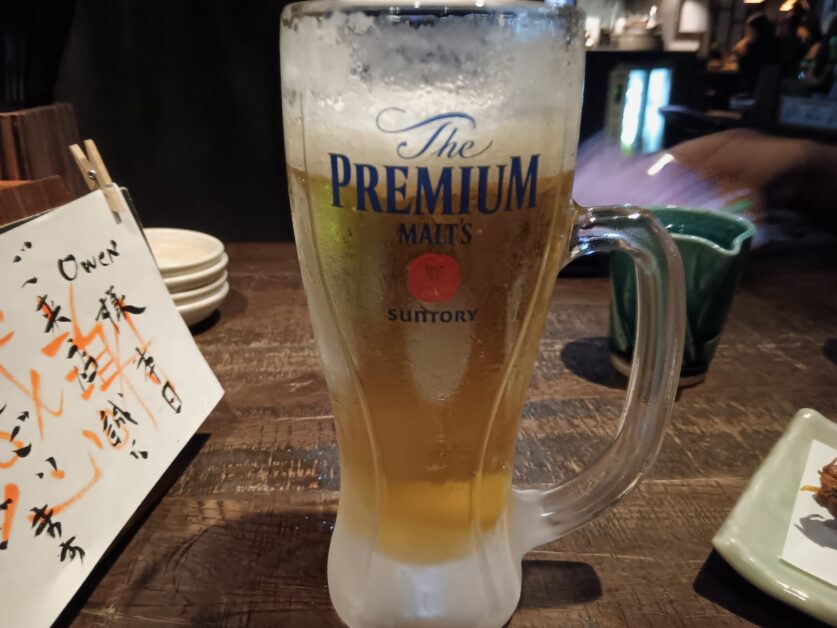
I was a bit disoriented from a long week of work so forgot to take photos of the two bottles of sake we consumed.
Second, it’s reasonably priced and possibly the most affordable izakaya that I’ve eaten at in Hong Kong. The bulk of the “doll hairs” that you’ll be shelling out are for sake. Lunch sets (sashimi, unagi, udon, etc…) begin around HK$120 and most a la carte items are priced between HK$50 to $120-ish. There are very affordable, quality bottles starting around HKD$300. Draft beers, umeshu, and other alcohols range from HK$60 to $95 per glass.
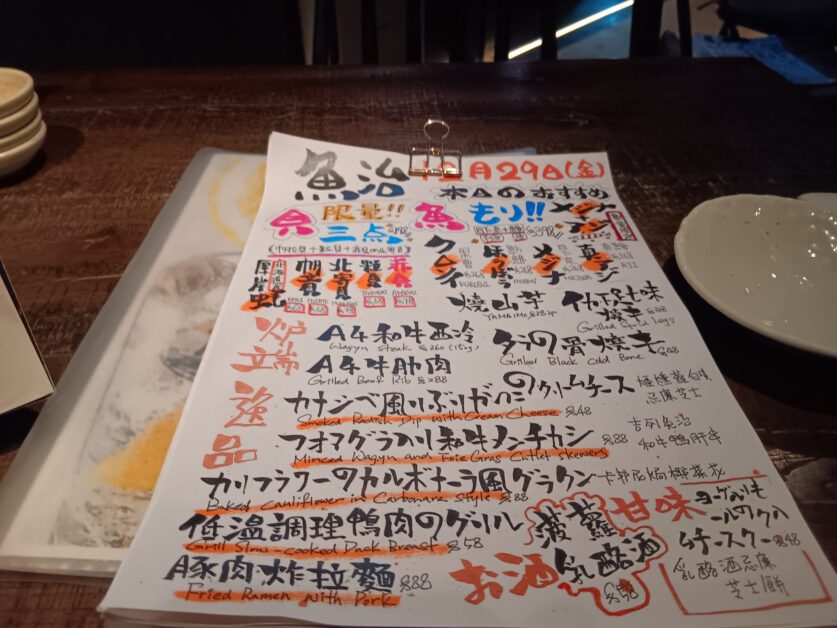
Third, Uoharu is a jack of all trades when it comes to izakaya fare and sports an astonishingly robust menu, so there’s always going to be something for everyone. For vegetarians, there’s more than a handful of ‘omnipork’ options as well. I’m generally skeptical of restaurants that try to do too much but having eaten everything from Uoharu’s sashimi to wagyu sandos, unagi bowls, and yakisoba, I can confidently declare that there isn’t much that they don’t do Japanese justice.
Finally, Uoharu’s staff is always ready to rumble in the best way possible. They are always extremely welcoming, attentive, and on top of everything.
Pale Ale Travel Anecdote: Don’t hesitate to ask me about the time that I drank so many yard-long craft beers at a horse meat tartare and venison restaurant in Bakurocho (Tokyo’s Northeast) that I woke up naked in the hallway of my hotel.
Robatayaki With a Fire Show
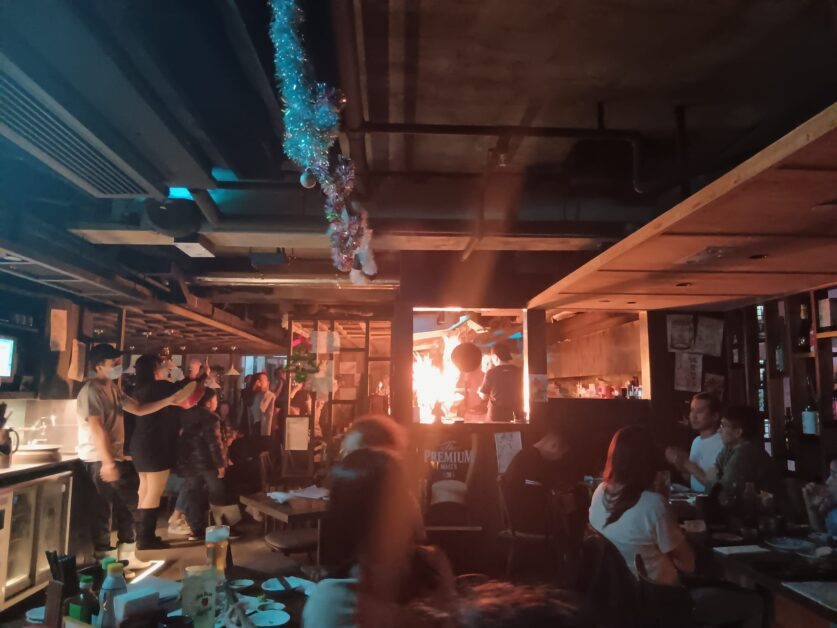
Several eyebrows were definitely burnt off during this show.
While Uoharu is a seafood-themed izakaya, it also bills itself as a ‘robatayaki’ spot as well – which is a method of cooking (similar to barbecue) where various items are cooked over hot charcoal on an open fireplace. I can’t say that too much seafood was actually consumed on my most recent trip as they were sold out of some of the major staples and my top roll-dawg was more amped up on their land animals.
One important note that I want to make is that this is NOT a yakitori spot. The majority of Uoharu’s dishes are plated and substantially more filling than skewers. Further, robatayaki is considered more formal and encompasses varying types of meats, vegetables, and seafood, while yakitori primarily focuses on skewering chicken-based morsels.
If you’re in the market for a great yakitori joint in town, don’t hesitate to reach out to me in the comments or via email!
Now, onto what we ate.
Fried Shrimp Roll
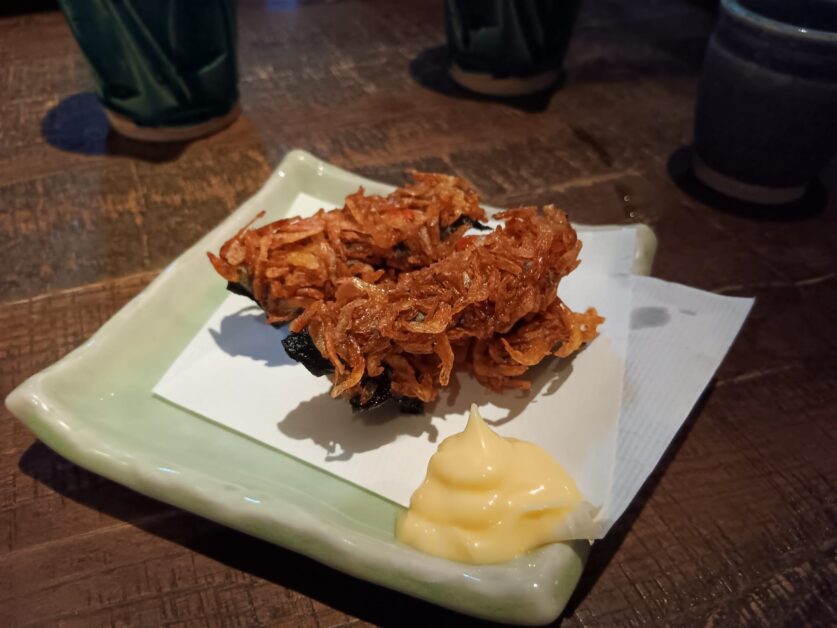
When I first ordered these, I thought I was doing my buddy a solid by ordering him some grilled sausages, so you can imagine my surprise when I bit into a crunchy, salty, egg roll-type of creation.
I’d call this “the most potent shrimp cracker I’ve ever eaten,” and an elevated take on the shrimp/prawn crackers you are typically served at a Southeast Asian restaurant. There’s some variety in texture with the cragged, crunchy, shrimp flake exterior, which contrasts nicely with a thin, delicate briny seaweed interior.
This was the first thing down my gullet and set the tone for the meal.
Lotus Root With Truffle Salt
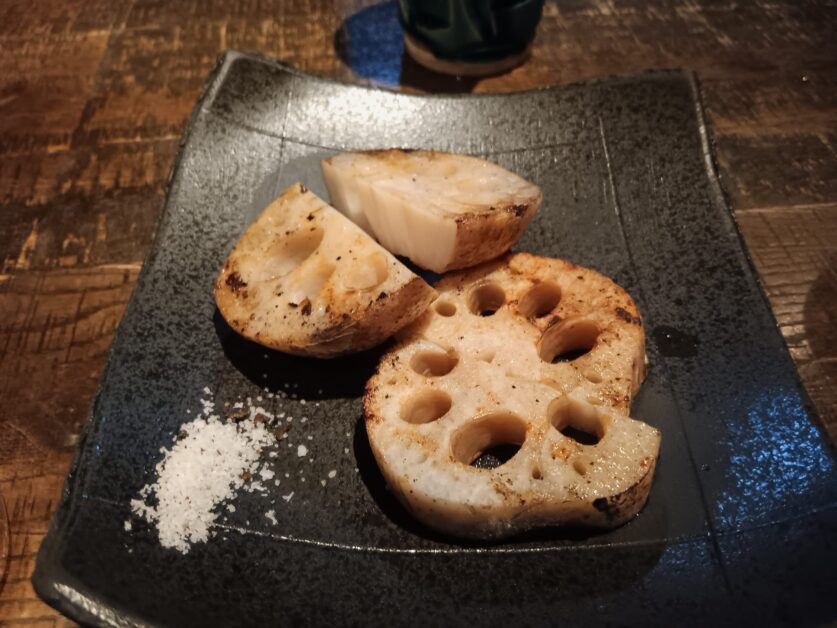
Lotus root is definitely a distinctive taste that might not be for everyone. It’s mild, yet sweet and slightly earthy, boasting a starchy, crunchy, and fibrous texture. It exists somewhere between celery and turnip on my scale of vegetable textures.
The accompanying truffle salt draws out the further earthiness of the root and actually “tricks” your brain into thinking the root is softer than it actually is due to the additional crunch. This is a snack that you can put back several of, as they are essentially healthy, thick-cut root “chips”.
Cherrywood Smoked Bacon
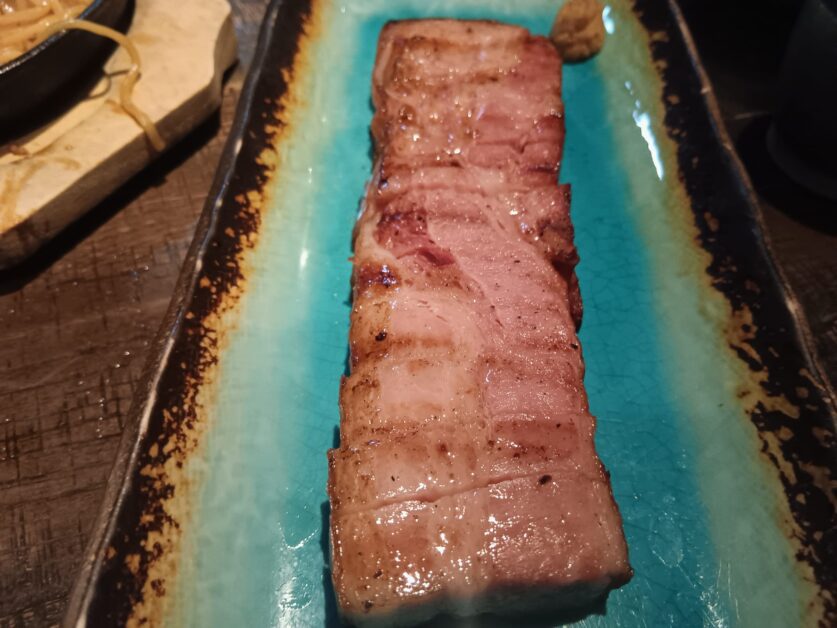
This may not sound that appealing but I would equate this far more to ham than I would bacon. However, it was one of the single best cuts and bites of ham I’ve eaten in Hong Kong (not like I’m just devouring ham on the reg).
The sweetness and slight tartness of the cherrywood smoking come through and caramelize the outside, turning each bite into your own mini-glazed ham. It’s served with a side of wasabi to cut through the sweetness and is a flavor combination I didn’t know I needed until trying it.
Thick-Cut Beef Tongue
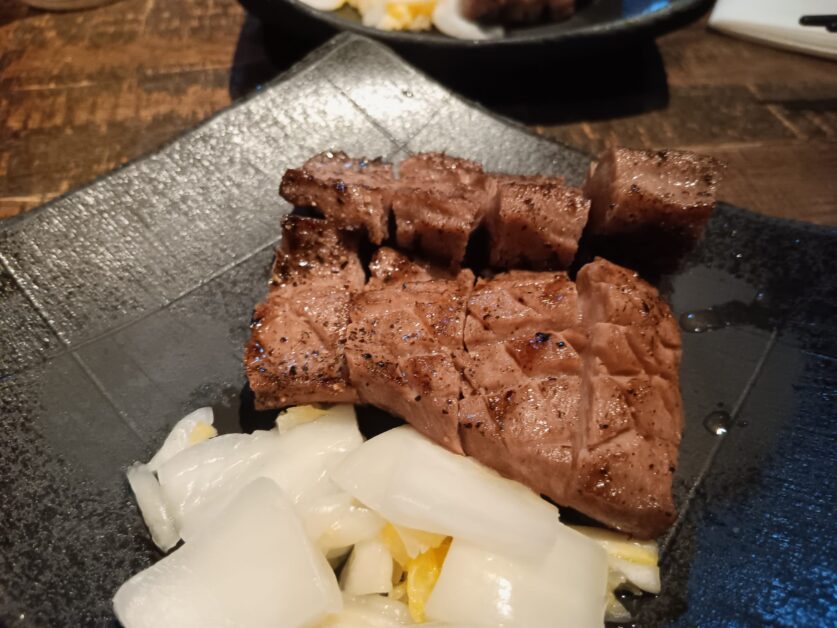
The biggest issue I’ve run into when cooking thick-cut beef tongue is that if you undercook it, it’s going to end up like an eraser. While I’m typically a huge proponent of beef tongue, when it’s not done properly it can be a bit disappointing.
The above thick-cut beef tongue did boast its signature ‘deep beefy’ flavor (and was seasoned perfectly), however, it was slightly undercooked and chewier than I generally like. Then again, I did order two plates of it so I’m not sure what I’m complaining about.
Overall, it’s a great dish at Uoharu but I imagine it can vary depending on the day and how long it was cooked.
Kagoshima A4 Wagyu Sando
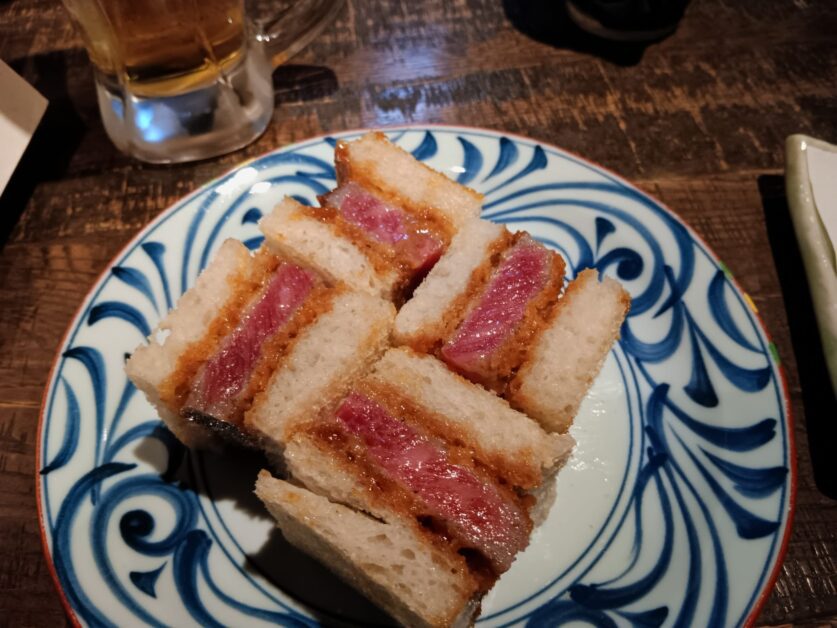
This was the most expensive dish of the night but well worth it, clocking in at HK$270-ish. It is one buttery sando. I mean that in the way that it’s smooth, light, and tender, and a dish that can be polished off in less than 20 seconds if you’re not careful. Kagoshima wagyu is known for its tenderness and well-balanced intramuscular fat content that creates a juicy network of fine-grain, soft beef.
The katsu sauce adds a sweet, savory, and tangy addition to balance the richness of the Kagoshima wagyu (keeping it nice and light) and “sticky” texture to the fried panko breadcrumb exterior. I split this with my buddy and ate both pieces in two bites.
Chicken Thigh With Salt
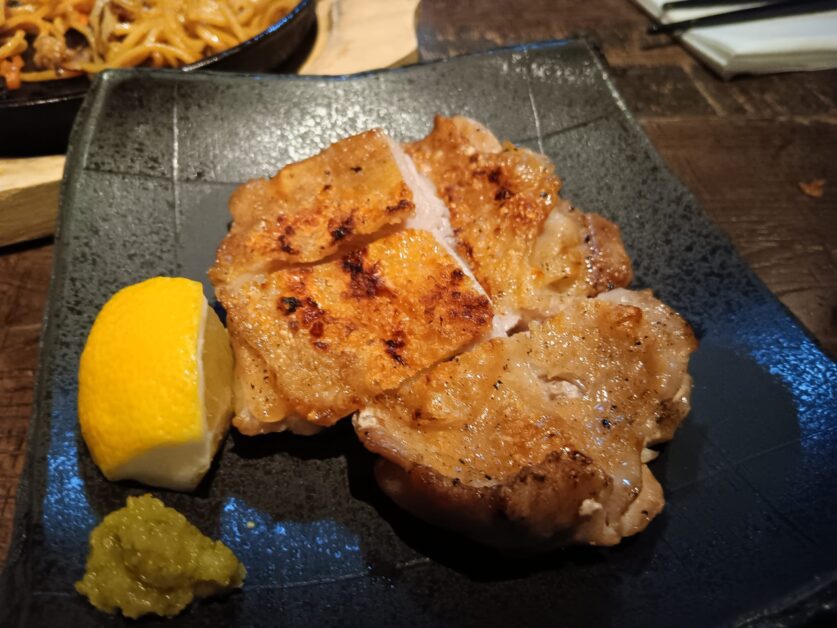
Robatayaki has a way of locking in all the juices while still yielding a crackling, crispy exterior. My buddy isn’t a massive fan of the crackling skin, however, this is exactly how I prefer chicken served at an izakaya.
The use of chicken thigh is deliberate as it’s a fattier, more intense flavor that doesn’t dry out on the open flame grill (which is dishing out some high, high heat). It also typically comes with the skin attached which is essential for encasing the juicy interior after it crisps up.
This is snap, crackle, and pop all in one bite.
Kagoshima Black Pork
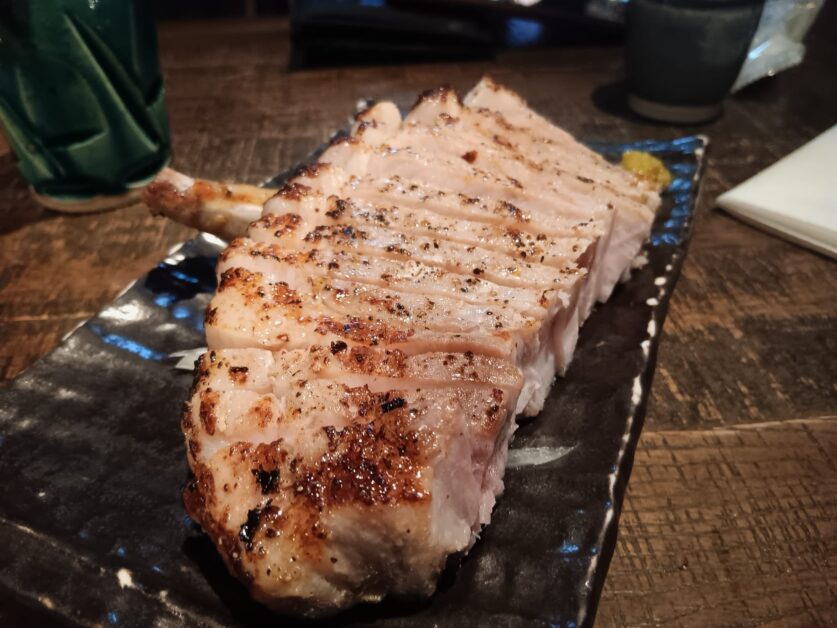
Uoharu’s Kagoshima black pork is one of my favorite dishes on the menu. Kagoshima pork, also known as ‘Kagoshima Berkshire pork’, is known for its tenderness and “melt-in-your-mouth” taste (similar to Kagoshima wagyu) due to high levels of intramuscular fat. Whatever they do to their livestock down there, it works.
Because of how high the quality of pork is, the dish is typically served with a slightly pink interior which also helps lock in the juices more.
My buddy found the pork to be a bit too peppery and over-seasoned. However, I personally enjoy a full-body sneeze so it was right up my alley.
Yakisoba
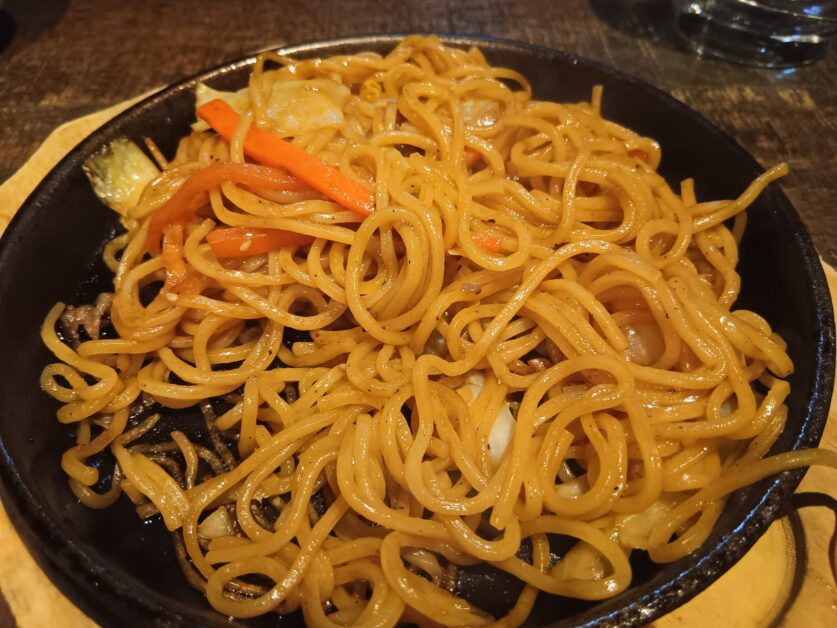
The best part of the yakisoba is where it crisps up at the bottom and sticks to the pain, leaving crunchy, slightly smokey noodle bites.
There’s not much to say other than that these are damn good chewy, wheat noodles that are imbued with a slight sweetness from the cabbage, carrots, and onions.
Bonito (“On the House”)
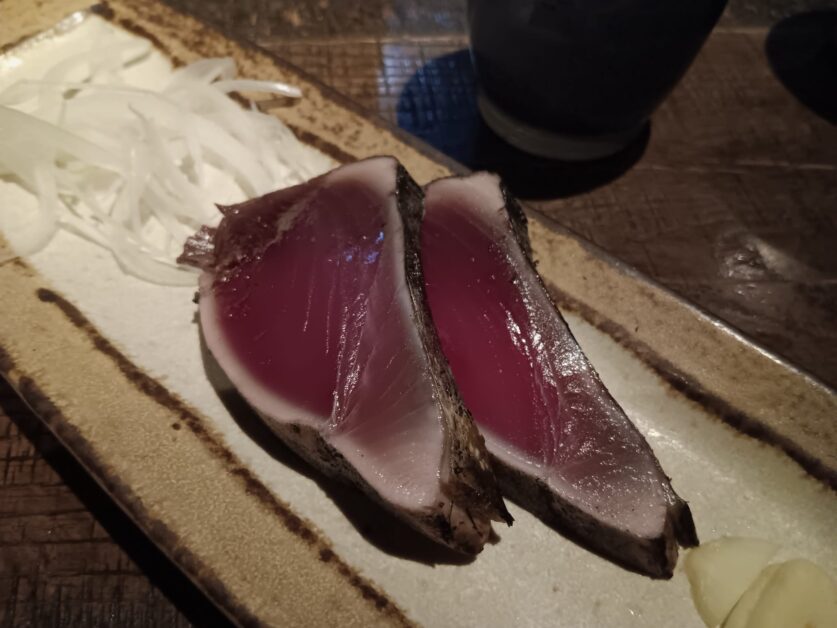
Every night at 9 PM, Uoharu puts on their signature ‘Robatayaki show’ where they pull something out of The Last Airbender and light a massive fire on their robatayaki grill, which they manipulate into various shapes and grill bonito fish. This is then passed out to diners “on the house.”
Bonito definitely is not a contender for my top fish out there as it tends to be a bit oilier and “fishier” than most fish served at an izakaya. But it was free and sported a nice bark along the outer edges from the fire show, and was reminiscent of a working-class tuna.
Other favorites not pictured or consumed on that bro-licious night include Uoharu’s ‘Atka Mackerel’, ‘Squid with Squid Liver Sauce’, ‘Beef Croquettes’, and ‘Grilled Beef Ribs’.
Pale Ale Travel Tip: If you’re in the mood for more Japanese cuisine done right in Hong Kong, specifically ramen, make sure to check out my guide breaking down the best ramen restaurants in Central.
There’s Nothing Askew About Uoharu
If you’ve read any of my other posts rants where I mention the Japanese cuisine landscape in Hong Kong, then you know that I find it to be the most overpriced, low-quality fare in the city. Uoharu is the exception to the rule.
This might be one of the only izakayas in Hong Kong where I don’t feel like I’m being fattened up for the slaughter like a newly divorced guy after he receives a seductive WhatsApp message from an attractive female and is ultimately taken to the cleaners in an elaborate crypto scam.
Uoharu always delivers when it comes to getting my “izakaya fix” at an affordable price, without compromising on quality, and is definitely worth checking out if you’re as jaded about Japanese food in Hong Kong as I am.
If you’ve been to Uoharu, I’d love to hear from you what your thoughts are and what your favorite dishes are. Also, if you have any favorite izakayas in Hong Kong, please let me know as I am always looking for new spots to try, incorporate into my gastronomic routine, and write about!
Eat and drink well everyone,
Big Body
Big Body is a voracious lov…eater, a cowardly fighter, and a self-proclaimed curry goat BBQ-eating champion (don’t forget the donkey milk) who likes Stoicism, baseball, and writing in the third person. Having worked for himself for the last 7 years, he isn’t particularly successful but he does still drink ice-cold Sapporo draft beers with the best of them and knows his way around a Dai Pai Dong or two. He is based in Hong Kong but you can still find him in Saigon, Osaka, and Vienna for extended periods.
